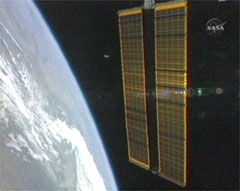

The world's first bionic woman Claudia Mitchell didn't even know about the 1970s show when she heard the term.
When her doctors first called her "The Bionic Woman," 26-year-old Claudia Mitchell didn't understand the reference to the 1970s TV show about the secret agent who was part woman, part machine.Cyberpunk is just around the corner.
Besides, the first woman to be outfitted with a bionic arm says that when the motors are running in the 10-pound device, it reminds her of another famous cyborg - Arnold Schwarzenegger's The Terminator.
"It's really cool," she says. "This is not just something in the movies. This is really happening." Mitchell, a former U.S. Marine, lost her left arm in 2004 on an Arkansas highway when the friend she was riding with lost control of his motorcycle.
As she struggled to cope with the loss of the limb, she read a Popular Science story about Jesse Sullivan, a Tennessee man who received the first bionic arms at the Rehabilitation Institute of Chicago after losing his in an electrical accident in 2001.
"I said, 'I've got to have one of those,' " Mitchell says.
Last year she had surgery and received an arm that's even more advanced than Sullivan's. Today, in a Washington, D.C., news conference with National Institutes of Health officials, Mitchell will show off her skills with the arm developed in a $4 million project funded largely by the NIH.
Though recent prosthetic research has focused on implanting sensors that link devices to movement commands from the brain, Mitchell was drawn to the less-invasive work in Chicago.
"Most people have been looking at trying to tap into the brain, but that has a number of challenges," says Todd Kuiken, who heads neural engineering at the Chicago institute. Implants are "becoming more doable, but if something breaks you have to have surgery to fix it. The exciting thing about this technique is we are not implanting anything into her body."
Kuiken found a way to use chest muscles to connect the prosthetic to nerves that once sent signals to the hand, wrist, elbow and shoulder. After an amputation, the brain still thinks the arm is there. It feels sensations and sends signals to move. But those signals are too weak for modern mechanics to detect from the surface of the skin, so Kuiken's team amplified them.
First, plastic surgeon Greg Dumanian of Northwestern Memorial Hospital moved the targeted nerves into muscles in Mitchell's chest. Then, the nerves that cause the motion of those muscles were disconnected. Mitchell can no longer send a signal to flex her pectoral muscle, but when she wants to close her hand or bend her elbow, the nerve impulse moves her "pec."
When that muscle moves, it sends a signal strong enough for a sensor on the skin to detect. After some rewiring by Dumanian, six muscles in Mitchell's chest now move six motors in the bionic arm.
And nerve data flow up, too. When Kuiken touches a certain spot on Mitchell's chest, she feels him touch her hand, even though it's no longer there.
There is much still to sort out. Though Mitchell can perform a simple task such as folding a pair of pants without first stretching them out on a flat surface, Kuiken calls the arm clumsy. Both he and Mitchell say they are optimistic about making the prosthetic - hers and future versions - more sensitive and precise.
"We hope to be able to close the loop with Claudia and have the sensation be there so that when she touches something, she feels a touch of her hand," Kuiken says. Mitchell, who hopes to go to college next year to study communications, says she is proud to be part of the team. "I am really excited about the prospects of being able to, hopefully, pave the way to make this something that is more common," says Mitchell, a volunteer at Washington, D.C.-area military hospitals.
Until today, her role in the bionic research project has been shrouded in secrecy. But now, the former Marine who served in Kuwait can tell the amputees she counsels about her arm and the research.
ISS Spreads Its Solar Panels

The crew of Space Shuttle Atlantis are looking to do one more spacewalk.
Joe Tanner and Heidemarie Stefanyshyn-Piper, the pair who did the first spacewalk on Tuesday, are going out for the third and final excursion this morning.All's well that works well.
"You just can't imagine a flight going as well as this one has gone," said lead space station flight director John McCullough. The astronauts have been working on installing a new addition to the space station, the first since the 2003 Columbia disaster. "I couldn't ask for a better start - a re-start - to assembly," McCullough added.
The US$372 million addition consists of two solar panel wings that will eventually provide a quarter of the space station's power when it's completed by 2010. They won't generate any electricity, though, until the next space mission - slated for December - when the power system is rewired.
On Friday's spacewalk, Tanner and Piper will be unpacking a radiator that will later be used to dissipate the heat generated by electronics on the newly installed solar panels.
They'll spend the rest of the roughly 6 1/2 hours with tasks like replacing an antenna and picking up science experiments.

1 comment:
It's great to see really useful prosthetic limbs like this one starting to come out :) You're right - cyberpunk *is* just round the corner - raising all the possibilities of that fictional world. How long till RoboCop?
Post a Comment